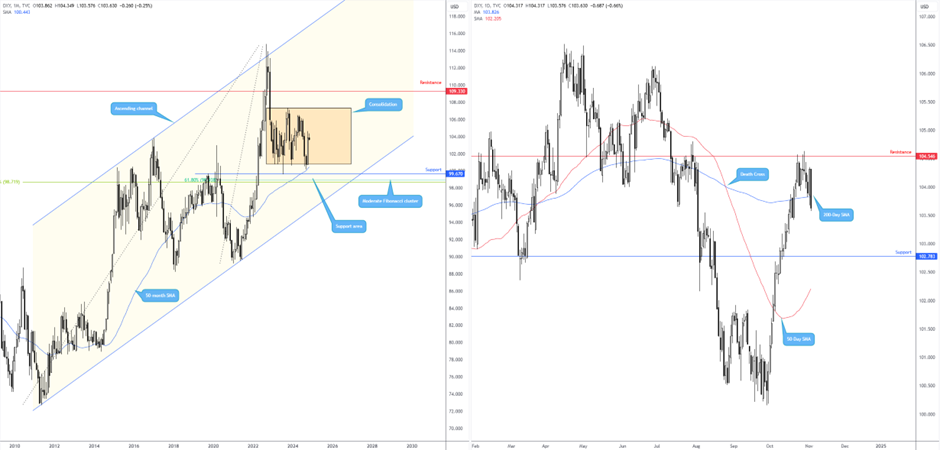Market watchers and investors are preparing for one of the most significant weeks of the year: the United States (US) presidential election takes place tomorrow, and the Federal Reserve (Fed) will announce its interest rate decision on Thursday. Both events could significantly impact global markets, potentially influencing currencies, equities, bonds, and commodities.
Who will be the next President of the world’s largest economy?
Over the past few months, Democratic nominee, Vice President Kamala Harris and Republican nominee, former President Donald Trump, have been running neck-and-neck in both national polls and state surveys, making it clear that both candidates have about an even chance of winning tomorrow’s election.
The presidency will ultimately be decided by the Electoral College outcome, which will be based on the election results in individual states. Each state’s number of electors is proportional to its population size. There are 535 electors for the 50 states and 3 for the District of Columbia; that is a total of 538 electors.
A candidate must gain a majority of the electoral votes – 270 or more – to win the presidency and for their running mate to become the vice president. If no candidate wins 270 electoral votes, a contingent election occurs: the House of Representatives will elect the president, and the Senate will be tasked with electing the vice president. This makes it possible that the House elects a president from the majority’s preferred party while the Senate chooses a vice president from the other.
It should be noted that a candidate may win the popular vote across the country but lose the Electoral College vote. This has happened five times in the past, with the most recent being in 2016 when Trump won the presidency despite trailing behind Hilary Clinton by nearly three million votes nationwide.
The 5 November election will also determine which party controls Congress; there are 435 seats in the House of Representatives and 34 seats in the Senate up for grabs. Currently, Republicans hold a majority in the House, while Democrats control the Senate – albeit both by slim margins. Polls suggest the control of each chamber could switch this election round.
With less than 24 hours to go for the election and more than 77.6 million votes already cast, ABC News/FiveThirtyEight’s latest polls indicate that Harris holds a marginal lead over Trump with 47.9% vs 47.0%.
Battleground states set to determine the election result
The seven battle states have a total of 93 electoral votes – with polls indicating razor-thin margins. According to the latest New York Times/Siena College polls, Harris is ahead by three percentage points in Nevada (49% vs 46%), two points in North Carolina and Wisconsin (48% vs 46% and 49% vs 47%, respectively), and one percentage point in Georgia (48% vs 47%). Trump maintains his advantage in Arizona, leading by four percentage points (49% vs 45%).
Interestingly, the polls show that the two candidates are locked in close races in Michigan and Pennsylvania, with results in all seven states within the margin of error – meaning neither candidate has a definitive lead.
Election results and market impact
Exit polls are expected to begin rolling in at approximately 5:00 pm Eastern Time (ET). While these results do not show ‘the full picture’, they can provide early insights and volatility may increase as a result. However, market participants are likely to exercise caution, and rightly so. Results will be adjusted numerous times throughout the evening as more votes are counted.
The reporting of results from major swing states will be a crucial period for traders. The process starts with the polls closing in Georgia at 7:00 pm ET and concludes with the results from Nevada at around 10:00 pm ET. You can expect volatility to surge once all the key states’ results are reported at about 11:00 pm ET.
Early AM (ET) on 6 November, investors will have more clarity on a potential election winner. While a winner is usually clear at this point, if there is uncertainty, or talks of recounting, markets may consolidate as this could result in legal action from both sides. It is also important to acknowledge that although a winner is generally clear on election day, there are instances when the outcome may not be determined for several hours, days, or even weeks.
-
A clean sweep for Trump is expected to boost demand for the US dollar (USD) and US equities, as well as a rise in US Treasury yields in response to fiscal stimulus. Trump’s pro-growth and domestic policies, and potential for tariffs, could lead to demand for stocks in the financial and energy sectors. Additionally, major cryptocurrencies could catch a bid amid Trump’s ‘plans’ to make the US the ‘Crypto Capital’ of the planet.
-
A clean sweep for Harris is likely to weigh on the USD and US Treasury yields amid less tax cuts and increased spending. Major US equity indices could take a hit on a Harris victory, though the reaction is likely to be mixed.
Fed poised to cut by 25 basis points
In addition to the US elections, the Fed will claim a portion of the attention this week, scheduled to make the airwaves at 7:00 pm GMT on Thursday. Markets are fully pricing in a 25-basis point (bp) reduction, a move that would bring the target for the funds rate to 4.50-4.75%. The elections are unlikely to sway this decision. In fact, anything other than a cut – particularly following the bumper 50 bp reduction at September’s meeting, the Fed’s latest dot-plot suggesting 50bps of additional easing this year, and robust economic data – would catch the markets off guard and may prompt investors to question whether the Fed made a mistake going for ‘50’ in September. Investors are also expecting another possible 25bp cut at December’s meeting (20 bps of cuts currently priced in).
Robust US economic picture
The US economy remains on solid footing, with the Fed still focussed on achieving a soft-landing scenario.
-
Inflation eased for a sixth consecutive month in September, cooling to 2.4% from 2.5% in August – its lowest level since early 2021 – while core inflation increased to 3.3% in September from 3.2% in August.
-
In terms of payrolls, job growth recently ground to a halt, adding a paltry 12,000 jobs to the economy in October (market consensus: 113,000). While this was a surprise, the lower-than-expected print was influenced by weather and strikes, therefore, the Fed are likely to overlook this print and emphasise that attention needs to be on longer-term trends. Unemployment remained unchanged at 4.1%, and wage growth accelerated, which is concerning, with both month-on-month and year-on-year measures showing increases.
-
The latest figures also show that Q3 24 Gross Domestic Product (GDP) grew by an annualised rate of 2.8% (according to the first [advance] estimate), defying analyst expectations of 3.1% and the 3.0% reading in Q2. One of the main drivers behind the economy’s resilience was robust consumer spending (up 3.7%).
Dollar Index on the ropes
Realistically, longer-term chart studies on the monthly timeframe reveal that the USD has largely been directionless since the beginning of 2023, fluctuating between 100.82 and 107.35. Note that the lower edge of the said range is joined by the 50-month simple moving average (SMA) at 100.44.
However, while the greenback is trading mid-range on the monthly timeframe, price action on the daily timeframe recently crossed beneath its 200-day SMA at 103.83 after shaking hands with resistance at 104.55 in late October. Technically, assuming a daily close beneath the noted SMA, further underperformance could be seen in the USD towards support at 102.78.
This article is sponsored content
This material on this website is intended for illustrative purposes and general information only. It does not constitute financial advice nor does it take into account your investment objectives, financial situation or particular needs. Commission, interest, platform fees, dividends, variation margin and other fees and charges may apply to financial products or services available from FP Markets. The information in this website has been prepared without taking into account your personal objectives, financial situation or needs. You should consider the information in light of your objectives, financial situation and needs before making any decision about whether to acquire or dispose of any financial product. Contracts for Difference (CFDs) are derivatives and can be risky; losses can exceed your initial payment and you must be able to meet all margin calls as soon as they are made. When trading CFDs you do not own or have any rights to the CFDs underlying assets.
FP Markets recommends that you seek independent advice from an appropriately qualified person before deciding to invest in or dispose of a derivative. A Product Disclosure Statement for each of the financial products is available from FP Markets can be obtained either from this website or on request from our offices and should be considered before entering into transactions with us. First Prudential Markets Pty Ltd (ABN 16 112 600 281, AFS Licence No. 286354).
Recommended Content
Editors’ Picks

AUD/USD hung out to dry on familiar low end
AUD/USD tried and failed to spark a bull run during the first trading session of 2025, rising on thin volumes before collapsing back into the 0.6200 handle in the later hours of the day. A broad-market push into the safe haven Greenback kept the Aussie pair on the defensive, and the AUD is mired in congestion on the weak side of two-year lows.

USD/JPY flirts with multi-month highs in the 158.00 region
The USD/JPY pair traded as high as 157.84 on Thursday, nearing the December multi-month high of 158.07. Additional gains are on the docket amid prevalent risk aversion.

Gold flat lines above $2,650 ahead of US PMI release
Gold price consolidates its gains near $2,660 after reaching a two-week high during the early Asian session on Friday. The safe-haven flows amid the geopolitical tensions provide some support to the precious metal.

Could XRP surge to new highs in January 2025? First two days of trading suggest an upside bias
Ripple's XRP is up 7% on Thursday, extending its rally that began during the New Year's Day celebration. If long-term holders continue their recent accumulation, XRP could overcome the $2.9 resistance level and aim for a new all-time high.

Three Fundamentals: Year-end flows, Jobless Claims and ISM Manufacturing PMI stand out Premium
Money managers may adjust their portfolios ahead of the year-end. Weekly US Jobless Claims serve as the first meaningful release in 2025. The ISM Manufacturing PMI provides an initial indication ahead of Nonfarm Payrolls.

Best Forex Brokers with Low Spreads
VERIFIED Low spreads are crucial for reducing trading costs. Explore top Forex brokers offering competitive spreads and high leverage. Compare options for EUR/USD, GBP/USD, USD/JPY, and Gold.
